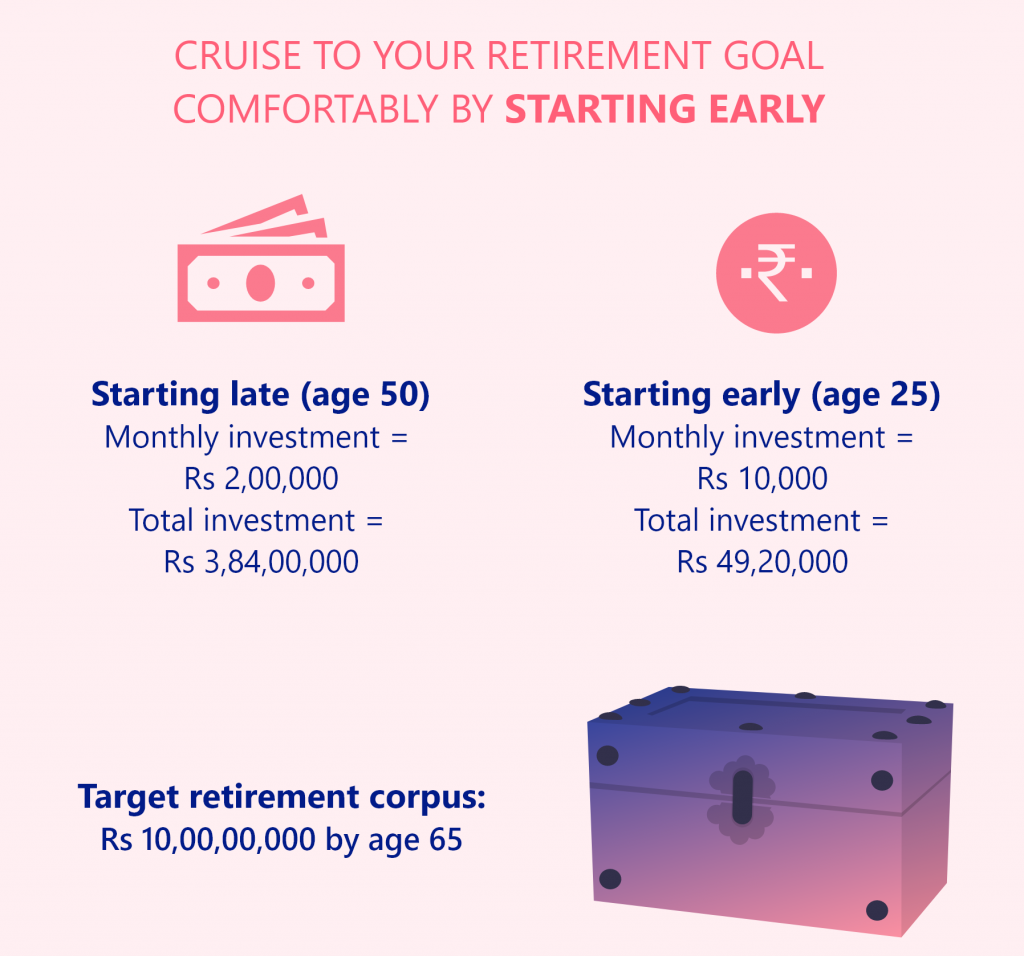Key Takeaways
- Retirement planning is the freedom to do what you please, be it not working, travelling the world, starting a business or anything else you dream of, without having to worry about your day to day sustenance.
- The steps to retirement planning involve setting a target age, estimating income needed, calculating the size of the corpus, creating a savings and investment plan, and putting it into action.
- You should start saving and investing for retirement as early as possible as this can make a significant difference to the amount you need to set aside to achieve a certain retirement goal.
The Oxford dictionary defines retirement as “the action or fact of leaving one’s job and ceasing to work”. We at Cashvisory believe that retirement is so much broader than this narrow definition. Retirement to us is freedom, freedom to do what you please, be it not working, travelling the world, starting a business or anything else you dream of, without having to worry about your day to day sustenance. Sounds like utopia, doesn’t it?
However, when we are caught up in the grind of life – that next Eurotrip, the house upgrade, our kids’ future – we often think of retirement as being too far away and as something that can be taken care of in the future. This is a huge mistake, which at its best will end up costing us much more than necessary, and at its worst may see us be left without adequate retirement funds to sustain ourselves.
In this blog post, we break down the steps of effective retirement planning and look at just how much of an impact planning early can make on your current and future finances.

How to do retirement planning: Step-by-step
Step 1. Setting a target retirement age – The first step is setting a realistic timeline for retirement that we wish to achieve. The targeted retirement age also tells us how many years of income we will need to sustain our life post retirement along with some buffer.
Step 2. Estimation of retirement income needed – This step involves evaluating what our inflation adjusted expenses could be post retirement, which will ultimately define the quality of life we will have. So it’s critical to think through this step thoroughly.
Step 3. Calculating the retirement corpus needed – With steps 1 and 2 completed, we can now reverse calculate the size of the war chest we need at the point of retirement.
Step 4. Creating saving and investing plans – This is a systematic plan that needs to be formulated to realise the retirement corpus in the timeframe that we have determined in step 1.
Step 5. Putting it in action – Now that your plan is ready, put it to work and watch it grow over the years!

When should you start planning for retirement?
To a 25 year old fresh graduate who has just started working, retirement seems very far away! So they work hard, earn, save, fulfill their near term obligations and start thinking about retirement only when they are nearing the actual retirement age. This is exactly where many of us miss out.
Let’s review this using a hypothetical situation of two friends who have different approaches to retirement planning. The end goal for both is to achieve a retirement corpus of Rs 10 Crore by age 65 (assumed rate of return is 12%).
- Raj decides to focus on his near term obligations first and pushes retirement planning all the way to age 50.
- He needs to invest Rs 2,00,000 per month until retirement.
- His total invested amount comes to Rs 3,84,00,000.
- Priya decides to start early at age 25 by setting aside a small amount monthly for retirement.
- She needs to invest Rs 10,000 per month until retirement.
- Her total invested amount comes to Rs 49,20,000.
Priya got to her goal of Rs 10 crores by investing only about 13% of what Raj invested! Her monthly commitment was merely 5% of what Raj’s commitment was! This is the magic of compound interest. So next time you think you are ‘too young’ to plan for retirement, think about whether you want to secure your retirement without putting a dent into your income like Priya, or whether you want to put it off like Raj and risk not just a significantly higher cash outlay but a potential risk of not being able to meet your retirement goals at all should your income be impacted at a later stage in life.

Bottom Line
Retirement planning is an indispensable part of financial planning, one that consists of multiple steps to be undertaken throughout the course of your working years. The earlier you start, the better it is for you. Effective and timely planning is the key to achieving financial freedom in life.
Each of the steps for financial planning shared above require some degree of thought, analysis and decision making. We are coming up with smart tools to assist you in this journey to ensure you have a successful retirement. Stay tuned!